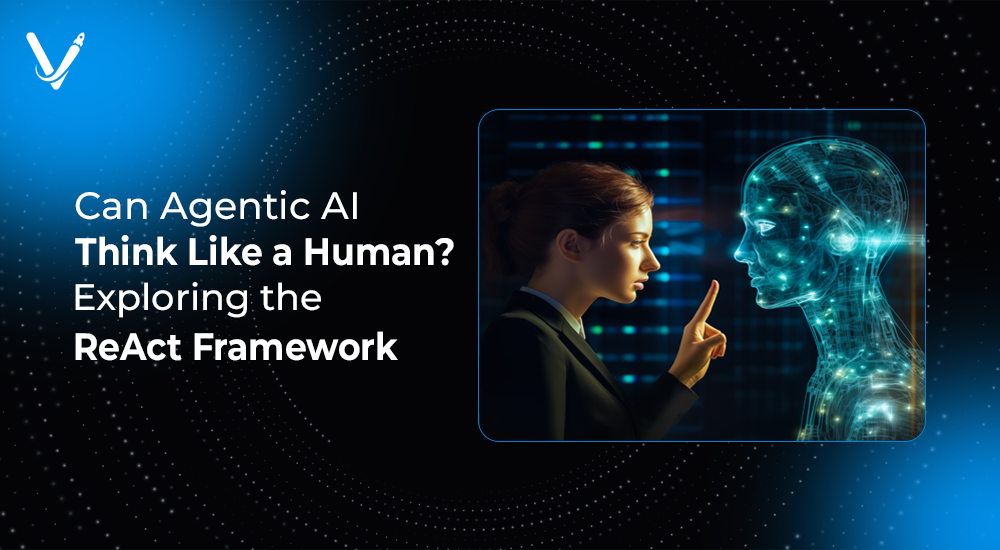Can Agentic AI Think Like a Human? Exploring the ReAct Framework


- May 29, 2025



Artificial intelligence has come a long way from simple rule-based systems to models that simulate aspects of human thought. Among the most revolutionary ideas pushing AI toward general intelligence is the concept of Agentic AI. This new paradigm isn't about building smarter chatbots or faster search tools—it’s about creating AI agents that reason, plan, and act like humans. At the heart of this movement is the ReAct framework, an approach that marries reasoning and action in a seamless loop, bringing us closer than ever to human-like AI thinking.
This post dives deep into the Agentic AI framework, examines how it mimics human cognition, explores the ReAct prompting technique, and analyzes the power and potential of agentic workflows in modern applications. We'll also answer critical questions like: Can AI solve real-world problems autonomously?, What are the limitations of current models?, and What is the best general purpose AI system by subscription today for Agentic AI tasks?
Agentic AI refers to artificial agents that don’t just passively respond to inputs but actively reason, plan, and make decisions to achieve goals. These systems exhibit behavior more akin to human problem-solvers than traditional ML models. An agentic AI:
In contrast to reactive systems, agentic AI is proactive, contextual, and iterative—just like a human brain tackling a tough problem.
With the rise of powerful language models like GPT-4, Claude, and Gemini, AI systems now have the language understanding necessary to mimic logical chains of thought. But what makes Agentic AI unique is its ability to combine language reasoning with tool usage and environmental interaction, enabling multi-step, goal-directed workflows.
ReAct (Reason + Act) is a framework that allows large language models to interleave reasoning and acting. Introduced by researchers at Google and Stanford, it empowers agents to:
Think aloud while solving problems.
Invoke tools like web search, calculator, or code interpreter.
Iterate actions and reasoning based on feedback.
This mirrors how humans solve complex tasks: we think, act, observe results, then think again. ReAct transforms static prompt-response models into dynamic interactive agents capable of solving real-world problems.
A ReAct agent follows this loop:
1. Observe: Takes user input or environment state.
2. Think: Generates a reasoning trace ("I need to find X because Y...").
3. Act: Uses a tool (e.g., searches the web, runs code).
4. Reflect: Observes tool output and reasons again.
5. Repeat until the goal is achieved.
This feedback-rich cycle enables learning and correction, just like how a human corrects mid-course based on new evidence.
Let’s compare agentic AI with traditional machine learning approaches:
Feature | Traditional AI | Agentic AI |
Decision Autonomy | Predefined or reactive | Goal-directed, proactive |
Tool Usage | None or hardcoded | Dynamic, on-the-fly |
Reasoning Process | Implicit (hidden layers) | Explicit (visible thought) |
Multi-step Task Handling | Limited | Natural and iterative |
Adaptability to New Problems | Low | High with tool feedback loops |
Agentic AI workflows are more flexible, interpretable, and resilient to change. That’s a game-changer for applications like:
Imagine assigning an agent a task like: "Compare the pricing, features, and reviews of the top three CRMs for small businesses." A ReAct agent would:
In healthcare, Agentic AI Issue Resolution is transforming triage systems. For example, an agent could:
In a DevOps setting, React agents can troubleshoot infrastructure failures by:
This dramatically reduces MTTR (mean time to resolution) and increases uptime.
React prompting refers to a prompt engineering method where the model is instructed to alternate between thought and action in a controlled loop. Here’s a typical prompt structure:
vbnet
CopyEdit
Thought: I need to find the latest stock price of Tesla.
Action: Search[“Tesla stock price”]
Observation: It is $245 as of 3 PM today.
Thought: That answers the question.
Final Answer: Tesla stock is $245.
This scaffolding allows the AI to externalize its logic, giving us visibility into why it took certain steps.
If you're exploring Agentic AI frameworks via SaaS platforms, here are some top contenders:
All these support agentic workflows to varying degrees. Choosing the best one depends on your domain, tool ecosystem, and latency needs.
Start with a clear goal like “Write a blog post on climate change using the latest research.” The agent should know the expected outcome and required tools.
Connect APIs or plugins for:
Use frameworks like LangChain or CrewAI to orchestrate them.
Structure your prompt as:
vbnet
CopyEdit
Goal: Summarize the top 3 breakthroughs in quantum computing this year.
Thought: I should search for recent papers.
Action: Search["latest quantum computing breakthroughs 2025"]
Observation: Found 3 papers on qubit stability, gate fidelity, and AI-assisted simulations.
Thought: I will summarize each paper.
Action: Read & summarize each.
Observation: Done.
Final Answer: ...
Persist long-term information with vector databases like Pinecone or FAISS. This lets agents remember past tasks and improve over time.
While promising, Agentic AI still faces limitations:
Models struggle with long-term memory. Current context windows (e.g., 32K tokens) are still limiting for complex workflows.
Incorrect tool execution (e.g., wrong API params or misinterpreting JSON) can break the workflow. Tool output parsing remains brittle.
Although React prompting reduces hallucination, agents can still make up facts—especially in speculative reasoning tasks.
Agentic workflows are resource-intensive. Running tools, memory lookup, and multi-step reasoning all add to latency and cloud costs.
We are just scratching the surface. The next wave of Agentic AI innovation may include:
Meta-reasoning: Agents that reflect on their performance.
Self-improvement: Agents that analyze and revise their own prompts.
Multi-agent collaboration: Teams of agents solving problems cooperatively.
Emotion and intent modeling: Mimicking not just cognition, but motivation.
This evolution will push AI closer to human-like autonomy, creating digital workers, tutors, analysts, and researchers.
The answer is nuanced: Agentic AI doesn’t replicate human consciousness, but it simulates our problem-solving processes remarkably well. With the ReAct framework, these agents can reason out loud, take actions, and improve their performance over time—just like a thoughtful, resourceful human.
This represents a leap forward in AI capability. Businesses, developers, and researchers now have tools that don’t just respond but actively work with you to solve challenges.
If you're looking to integrate Agentic AI workflows into your product or service, Vasundhara Infotech can help you design, develop, and deploy custom agentic solutions. Our team specializes in building intelligent systems that combine human intuition with machine speed—so you can stay ahead of the curve.
Copyright © 2025 Vasundhara Infotech. All Rights Reserved.